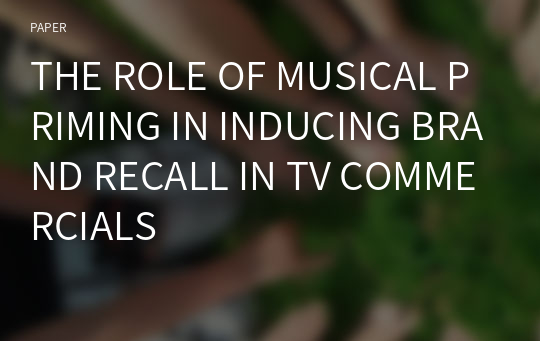THE ROLE OF MUSICAL PRIMING IN INDUCING BRAND RECALL IN TV COMMERCIALS
* 본 문서는 배포용으로 복사 및 편집이 불가합니다.
서지정보
ㆍ발행기관 : 글로벌지식마케팅경영학회(GFMC)
ㆍ수록지정보 : Global Marketing Conference
ㆍ저자명 : Gabriel Levrini
ㆍ저자명 : Gabriel Levrini
영어 초록
IntroductionAdvertisers use substantial resources to design effective multimedia ads, hoping to leave lasting remnants of brand information in the long-term memory of consumers (Wedel & Pieters, 2000). Brands use music as a way of expressing their personality and image with the public, and the sound must combine in a positive way and be in synergy with the other elements of the advertisement.(Sá, 2010). In the same way as priming concepts, there is an academic controversy on this theme in the academic literature. The explanation relies on the argument that ad music or background music is perceived initially when the stimulus happens, in a commercial for example, slowing or even inhibiting the consequent processing of branded message elements and reducing the recall to the background. The degree of this recall reduction depends on the music structural features as well as the advertised brand. (Hampshire et. al, 2010). So in this context we get to the research question: The stimulated music priming can be the induction item to brand recall advertised in a TV commercials. The purpose of this research is to analyse whether musical priming induces a greater recall of brands, with the utilization of Neuromarketing tools.
Gap
Gerald Gorn (1982) published "The Effects of Music on Advertising on Behaviour of Choice: A Classical Conditioning Approach" that proliferated dramatically in academic literature (as evidenced by 881 citations in Google Scholar, 266 in the Web of Knowledge in 2015. Gorns´ hypotheses have until now, been widely accepted by academia, which can be summarized as "cross modal" conditioning (in this case, a musical stimulus that influences affective responses to a visual stimulus) can effectively change consumer behaviour through a single exposure. The Gorn´s hypotheses still have relevance to the practice of traditional advertising and the current one, but they are subject to much controversy. Several authors (Allen & Madden 1985; Kellaris & Cox 1989) have argued that these effects may have been due to demand artefacts, rather than conditioned by Gorn's (1982) postulates. They cite as possible failure causes in the conclusions, for example, that demand artefacts may be the result of the presence of a non-blind experimenter, and that the research design may have explicitly related to music with the product, later corroborated by Vermeulen et al. (2014).
Methodology
The experiment was done in Pacífico Business School Neuroscience Lab in Lima, Peru in December 2017 with the presence of the researcher and two assistants.
Research design
For this research, was recruited a population of 80 millennials students (aged from 25 to 35 years old of both sex). – First, was edited six TV commercial unknown with music/jingles spots with the duration 20-30 seconds. Research equipment: In the Lab was used iMotions system through the implementation of the FACET module. Such module analyses the face images, in order to detect the movement by tension or relaxation of the muscles, identifying the Action Units (AU) after the detection of such units the correlation of the AU by the use of the Facial Action Coding System (FACS) deploys a value related with the probability of the emotion being displayed by the subject. For the registration of eye movements of the students a Tobii X2-30 device was used, with a Tobii pro3.4.8 software, manufactured by Tobii Technology (Tobii, 2014). This device works at a sampling frequency of 60 Hz and has a spatial resolution of less than 0.5º. The eye tracker was attached to a 24-inch TFT computer monitor with a maximum resolution of 1920 x 1200 pixels. Pre-test: All 80 members of the initial group in the Lab were initially stimulated the six videos, and at the same time they assures that they not recognized the spots. If positive, we asked to what TV commercial was related. From the group that did not recognize the spot we selected 40 individuals for the experiment. Another not stimulated group of 40 individuals was used as the control group in order to have external validity and reliability . Stimulus: To verify musical priming the experiment group repeated the test two other times (after 10 days after initial stimulation, to avoid short-term memories). After the experiment was asked to the participants to answered a questionnaire based on Well’s Brand Awareness scale (1993) that sought to verify the priming effect and attitude in relation to the brand.
Findings
Monitoring of eye tracking in real time and watching video of each participant’s session clearly revealed that in this pilot study the control group participants had a difficult time to recognize the TV commercials. The target group shown priming effect in both two spots. Average rated target group (M = 4.07, SD = 0.78) was significantly higher than control group [M = 3.57, SD = 0.94, t(135.7) = 3.47, p < 0.001].The results also suggest that music’s temporal differences provoked important priming effects. In the TD group, fixations were classified for 81.69 % (SD = 10.50) of the experiment. The overall looking duration (after filtering) did not differ between the groups (mean/SD for ASD = 10.41/1.91 s; mean/SD for TD = 11.02/1.45; t(80) = 1.437, ns). The total number of fixations (per TV commercial) was not significantly different between the groups (mean/SD for ASD = 36.05/12.10; mean/SD for TD = 45.00/22.36; ns, Mann–Whitney U Test). Similarly, the fixation rate (fixations per second) was equal across groups (mean/SD for ASD = 3.95/3.48 fixations/second; mean/SD for TD = 4.44/3.34; ns, Mann–Whitney U Test). The results inferred the power of music in priming effect.
Originality/value and practical implications
The utilization of neuroscience tools brought a new perspective, as stimuli reactions were observed in real time without self-related marketing and behavioural test exhaustive replicated before. Music is still an unexplained paradigm in human behaviour, but there is no discussion about its importance and business potentiality
참고 자료
없음"Global Marketing Conference"의 다른 논문
 THE ROLES OF GREEN PACKAGING IN UGLY FOOD PURCHASE INTE..22페이지
THE ROLES OF GREEN PACKAGING IN UGLY FOOD PURCHASE INTE..22페이지 THE IMPACT OF INDUCED AWE ON ETHICAL TOURIST BEHAVIORS5페이지
THE IMPACT OF INDUCED AWE ON ETHICAL TOURIST BEHAVIORS5페이지 A BIBLIOMETRIC ANALYSIS OF SPIRITUAL TOURISM RESEARCH15페이지
A BIBLIOMETRIC ANALYSIS OF SPIRITUAL TOURISM RESEARCH15페이지 SOCIAL NETWORK ANALYSIS AND RESPONSE TIME TESTING: CONS..11페이지
SOCIAL NETWORK ANALYSIS AND RESPONSE TIME TESTING: CONS..11페이지 THE EFFECTS OF PARA-SOCIAL INTERACTION ON ONLINE CELEBR..3페이지
THE EFFECTS OF PARA-SOCIAL INTERACTION ON ONLINE CELEBR..3페이지 THE INFLUENCE OF OPINION LEADERS ON DAILY DEALS USER’S ..3페이지
THE INFLUENCE OF OPINION LEADERS ON DAILY DEALS USER’S ..3페이지 HOW IMMERSIVE RETAILING AFFECTS CONSUMERS’ URGE TO BUY:..6페이지
HOW IMMERSIVE RETAILING AFFECTS CONSUMERS’ URGE TO BUY:..6페이지 KEY TO SUPERSTARDOM IN A GLOBALISED MARKET: THE ROLE OF..6페이지
KEY TO SUPERSTARDOM IN A GLOBALISED MARKET: THE ROLE OF..6페이지 A POST-PANDEMIC LOOK AT TOURISTS’ PERCEIVED COOLNESS OF..4페이지
A POST-PANDEMIC LOOK AT TOURISTS’ PERCEIVED COOLNESS OF..4페이지 EXTRACTING OFFLINE RETAIL SHOPPING PATTERNS: OLLABORATI..5페이지
EXTRACTING OFFLINE RETAIL SHOPPING PATTERNS: OLLABORATI..5페이지

























